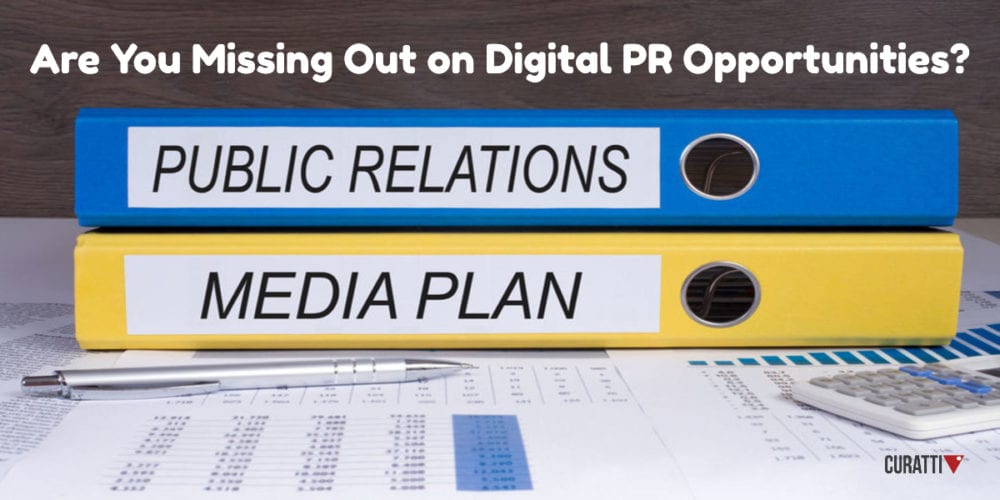Are You Missing Out on Digital PR Opportunities?

As any digital marketer knows, quality backlinks are valuable, as they directly contribute to your site’s SEO rankings.
Link building can help you acquire relevant links back to your site. Guest posting is a tactic often used for link building, but it can be very time-consuming and yields very few links.
Rather than spending countless hours on guest posting to acquire only a handful of links, you might consider a different approach: content promotion.
Content promotion is another way of getting links that can result in a higher number of backlinks in a shorter period of time.
More Than Traditional PR
Content promotion is often referred to as Digital PR because its process is similar to that of traditional PR. But unlike traditional PR methods, digital tactics result in more than just brand awareness and company mentions. If done the right way, Digital PR can result in brand coverage, lots of links, higher rankings in the SERPs and referral traffic to your company’s site. If that’s not appealing to you, you must not be a marketer!
This process requires a marketer to:
- Ideate and create appealing content
- Assemble lists of media contacts
- Compose press releases and media kits
- Contact members of online media outlets
- Monitor content coverage
Though it may seem daunting, this approach to link building can result in numerous links. When executed well, some pieces of content have generated hundreds of backlinks.
Brainstorm Content Ideas
Part of your digital content strategy should include creating promotable content. Do a content inventory and see if you’ve already got something to work with. You can update or modify an existing piece, if necessary. If not, come up with ideas that are consistent with your brand and the products or services you provide. These ideas don’t always need to be directly related to your brand but can be indirectly connected.
Look at content that received a lot of attention on other sites to get a good idea of what could work for your brand. Get inspiration from content that was shared a lot on social media, covered by news stations or other online publications, and yielded a high number of backlinks.
Investigate Your Topics
Once you have come up with a list of at least a few solid ideas, research each one. Find out if someone else has already created content based on the idea. You don’t even need to use tools, just try a few simple Google searches on your topic and look at what comes up. If someone else has already done it, that’s okay. You can still produce it, just make sure to do it better or add something else to make it different.
Look at these other aspects, too:
- Is your topic time-sensitive— Is it centered around a current news story, date, event, or holiday?
- Is it evergreen— will it always be relevant and useful?
- What audience would find it appealing— is it your target audience?
- Is the idea interesting enough that someone could tell a story about it?
- Is there enough information available to support your topic?
Be aware of timing and stay current on events and dates. Use holidays, national and international days, and even pop-culture references. Ideas that center around time-prompted subjects are seen as relevant to journalists and editors, which will make it likelier that they cover your content.
If you are going after an evergreen content approach, it should be something that won’t be outdated quickly or can be easily updated consistently and stay relevant. Evergreen content pieces can sometimes be comprehensive and lengthy, so keep that in mind when researching topics – especially if you don’t want to write a 12-page guide on your subject.
Be thorough in your investigation and use your findings to rule out some of your original ideas that won’t work.
Create the Content
Depending on the kind of content, creation can be tedious and time-consuming. Some pieces will require specific expertise, such as designing an infographic. Nevertheless, you can still successfully construct a great piece using tools like Canva or Easel.ly, among others. Make sure the type of content you create is something that will be easy to link to as an important reference for reporters and journalists. This could be a comprehensive guide, original data you have gathered and/or analyzed, a tool, or data presented in a unique way.
Create Email Lists
Your email lists are extremely important as they contain all of your press contacts. Each list should contain specific contact information for news stations, radio stations, and any other publications where you’re aiming to get coverage. Just make sure to target specific audiences and publications that are relevant to your brand and piece of content.
It’s also important to target the right people within a publication. If we’re going to pitch an infographic about the top ten benefits of smiling, we won’t look for the email of a tech site’s editor. Rather, we would search for the emails of health and wellness site editors. The same applies to news and radio stations. The people we would want to contact are journalists and reporters who have covered related topics. We also would find the general news and assignment desk emails.
Most, if not all of these emails are commonly found on the contact pages of the publication’s website. If not, they can often be found through social media platforms, the most widely used being Twitter.
Craft Press Releases & Pitches
Don’t think that press releases are an outdated element of marketing and PR— your press release is essential to getting coverage. It’s what gives editors and journalists necessary information about your company’s content, why it’s important to their audience, and all of the information they need to cover it.
Editors and journalists are busy people. At news stations, most journalists and reporters only have only a few hours to craft a story. At other online publications, editors get hundreds of emails daily and reading each one takes valuable time out of their day. If you send them a four-page document, chances are they won’t read it. If it’s too short and doesn’t include enough information, they probably won’t take the time to ask for more and wait on your response. While your press release doesn’t need to be anything spectacular, it does need to be concise and easy to browse.
In your press release, briefly lay out:
- What you are informing them about
- Why it’s important
- Why you think it’s relevant to them and their audience
- And show how them you are a credible source of the information.
Include a link to your brand’s original content within the email. If it’s not there, editors and journalists won’t take the time to find it online; they just won’t cover your content.
They aren’t lazy, just pressed for time. You need to make it as easy as possible for them to cover your content. It’s helpful to include a link to an online folder of a media kit. This can include photos, quotes, original sources of information, and anything else you think would be helpful for a journalist in covering your piece.
There are a lot of formats for presenting this information and plenty of press release templates are easily available if you are unsure.
Send Emails
Once you have created your press release template, it’s time to pitch all of the contacts you collected. Send the press release to each of your contacts from the email list you made. If you know the first name of the person you are trying to reach, make sure to address them. People will be more likely to respond if they can see that the email is personalized and that it’s not an automated junk email.
It’s also a good idea to follow up with people if they haven’t responded. After two or three days, just send them a short email in the same thread. You can say something like:
Hi (Name),
Any interest in covering (name and link to content)? I’m happy to answer any questions.
Thanks!
(Your Name)
(Company Name)
(Phone Number)
Sometimes emails get lost in news desk and editors’ inboxes, so they might miss your initial email and be grateful for a follow-up.
If you need a little help determining who you should send your emails to, this excellent article from NI Business Info may give you some tips.
Monitor Coverage
Once you’ve sent your emails, just wait for the coverage and links to start rolling in. You can use tools like Ahrefs and Buzzsumo to check for links or set alerts to inform you each time a new link is published. Through Google searches, you may come across some content coverage that mentions your website or brand but doesn’t link back. Simply email the site, thank them for covering your piece, then ask them if they will link back to the page on which the content was originally published. Sometimes journalists won’t link back even after you ask them, but many times they will.
Wrapping it Up
As a marketer, don’t be afraid of digital PR. It’s an important job that requires resilience and persistence. Your efforts in creating and promoting content will result in a high payoff— lots of links, higher organic search rankings, and an overall increase in site traffic.
Your Turn
Do you utilize any aspects of Digital PR? Do you have any further advice for your fellow readers on how they might get the best results? Please leave your comments below. Thanks.
Do You Need Professional Content Writing Services?
Click here to find out more[/wppsc
You may also want to read: 8 Low-Cost Publicity Tactics for Your Business
 Morgen Henderson grew up in West Jordan, Utah. She has experience in the family entertainment industry where her love of business and technology began to sprout. She spent a year and a half doing humanitarian work in the Dominican Republic, and loves to travel, bake, and learn about topics relating to technology and business. You can tweet her @mo_hendi
Morgen Henderson grew up in West Jordan, Utah. She has experience in the family entertainment industry where her love of business and technology began to sprout. She spent a year and a half doing humanitarian work in the Dominican Republic, and loves to travel, bake, and learn about topics relating to technology and business. You can tweet her @mo_hendi
Featured image: Copyright: ‘https://www.123rf.com/profile_convisum‘ / 123RF Stock Photo

CURATTI GUEST


